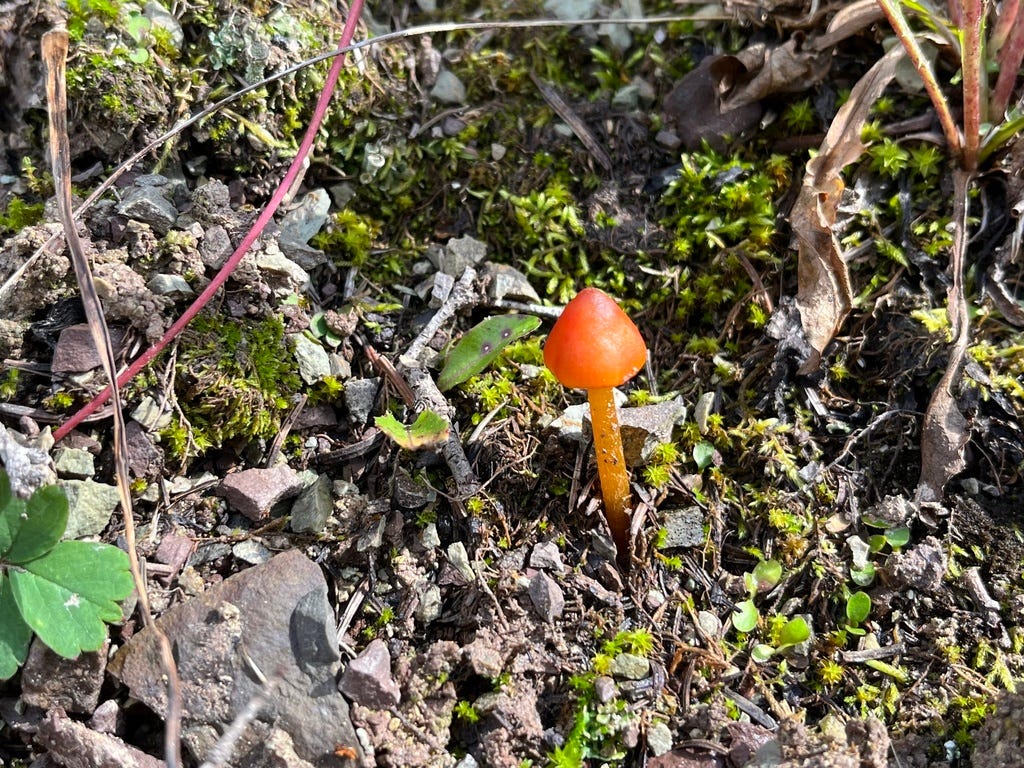Good evening, friends,
This week’s mushroom is the seasonally appropriate Witch’s Hat (Hygrocybe conica). I found these mushrooms a few times last summer when I went out to the Telluride Mushroom Festival, but only once have I seen them in the northeast. Despite my lack of success finding them here, they’re not uncommon, but it’s likely the species consists of many identical but genetically distinct mushrooms (known as a species complex). We’ll look at some of the traits that seem to be characteristic throughout the complex and how these mushrooms might even be helpful in preventing heart disease one day.
Fun Facts
In creepy, witch-like fashion this mushroom bruises black with age or when handled. Older specimens will be completely black and make identification quite difficult which leads to their other common name “the blackening mushroom”. The original color of the mushrooms can also vary, but the common form is a red cap with a red to yellow stipe.

The species name conica comes from the conical (cone-shaped) caps of the young mushrooms. The caps flatten out with age which can also lead to a more difficult ID. The genus Hygrocybe means “watery head” and refers to the moist, slimy texture of young caps. Like the conical shape, the slippery texture of the cap dries with age and leaves us with a candle-wax-like texture. Like a true witch, this mushroom is no stranger to shape-shifting and deception.

A couple scientific studies discovered some interesting information about the mushroom. One study tested 60 different mushrooms for their ability to “inhibit pancreatic lipase” - basically help prevent cardiovascular diseases - and H. conica demonstrated the highest inhibitory activity (Reference 3). H. conica showed inhibitory activity of 97% (with a 5% margin of error) compared to Orlistat, the commercially available pharmaceutical lipid inhibitor, at 51%. A different study surveyed mushrooms at severe burn sites and noted that H. conica fruitings were enhanced by fire (Reference 4).
Ecology
The fungus is apparently mycorrhizal with both conifers and deciduous trees, although that’s not known for certain. It seems that out west the mushrooms predominantly grow with conifers and east of the Rockies they associate with deciduous trees (more evidence that this is a complex of different species). The mushrooms pop summer through fall in the northeast but can also be found on every continent outside of Antarctica. They can fruit singly or in large clusters, but I was finding a few at a time when I encountered them.

A different Hygrocybe species I saw a bunch this year was the Vermillion Wax Cap (Hygrocybe miniata). This mushroom starts out a vibrant candy apple red before fading to orange. I also thought the above mushroom was the Yellow Unicorn Entoloma (Entoloma murrayi) when I first found it, but I took a spore print of the mushroom and the white spores were able to point me to Hygrocybe instead.
Thank you to everyone who showed up for the walk on Saturday. It was fun to meet some new MM readers, see old friends, and learn from each other and the park. We found some mushrooms I’d never seen in the park before - the Mossy Mazegill (Cerrena unicolor) and the Bicolored bracket (Gloeoporus dichrous). We also saw a Hen of the Woods (Grifola frondosa) growing at the base of an American Sweetgum tree (Liquidambar styraciflua). I’d known Hens to grow at the base of trees in the family Fagaceae (oaks, beech, and chestnuts), but last year I saw one on a maple and now this year on a sweetgum. Always fun to get out there and learn something new :)
Happy Halloween and Dia de los Muertos,
Aubrey
References:
Kuo, M. (2014, March). Hygrocybe conica. Retrieved from the MushroomExpert.Com Web site: http://www.mushroomexpert.com/hygrocybe_conica.html
Slanc P, Doljak B, Mlinaric A, Strukelj B. Screening of wood damaging fungi and macrofungi for inhibitors of pancreatic lipase. Phytother Res. 2004 Sep;18(9):758-62. doi: 10.1002/ptr.1548. PMID: 15478199.
Hughes KW, Matheny PB, Miller AN, Petersen RH, Iturriaga TM, Johnson KD, Methven AS, Raudabaugh DB, Swenie RA, Bruns TD. Pyrophilous fungi detected after wildfires in the Great Smoky Mountains National Park expand known species ranges and biodiversity estimates. Mycologia. 2020 Jul-Aug;112(4):677-698. doi: 10.1080/00275514.2020.1740381. Epub 2020 Jun 4. PMID: 32497465.







